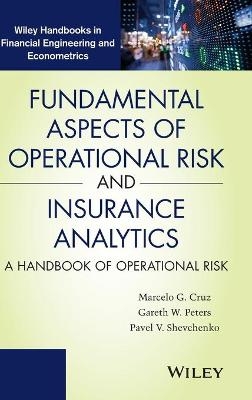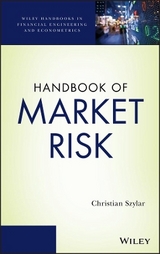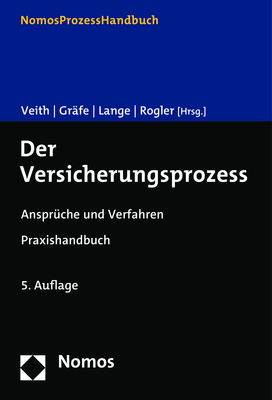
Fundamental Aspects of Operational Risk and Insurance Analytics
John Wiley & Sons Inc (Verlag)
978-1-118-11839-9 (ISBN)
A one-stop guide for the theories, applications, and statistical methodologies essential to operational risk
Providing a complete overview of operational risk modeling and relevant insurance analytics, Fundamental Aspects of Operational Risk and Insurance Analytics: A Handbook of Operational Risk offers a systematic approach that covers the wide range of topics in this area. Written by a team of leading experts in the field, the handbook presents detailed coverage of the theories, applications, and models inherent in any discussion of the fundamentals of operational risk, with a primary focus on Basel II/III regulation, modeling dependence, estimation of risk models, and modeling the data elements.
Fundamental Aspects of Operational Risk and Insurance Analytics: A Handbook of Operational Risk begins with coverage on the four data elements used in operational risk framework as well as processing risk taxonomy. The book then goes further in-depth into the key topics in operational risk measurement and insurance, for example diverse methods to estimate frequency and severity models. Finally, the book ends with sections on specific topics, such as scenario analysis; multifactor modeling; and dependence modeling. A unique companion with Advances in Heavy Tailed Risk Modeling: A Handbook of Operational Risk, the handbook also features:
Discussions on internal loss data and key risk indicators, which are both fundamental for developing a risk-sensitive framework
Guidelines for how operational risk can be inserted into a firm’s strategic decisions
A model for stress tests of operational risk under the United States Comprehensive Capital Analysis and Review (CCAR) program
A valuable reference for financial engineers, quantitative analysts, risk managers, and large-scale consultancy groups advising banks on their internal systems, the handbook is also useful for academics teaching postgraduate courses on the methodology of operational risk.
Marcelo G. Cruz, PhD, is Adjunct Professor at New York University and a world-renowned consultant on operational risk modeling and measurement. He has written and edited several books in operational risk, and is Founder and Editor-in-Chief of The Journal of Operational Risk. Gareth W. Peters, PhD, is Assistant Professor in the Department of Statistical Science, Principle Investigator in Computational Statistics and Machine Learning, and Academic Member of the UK PhD Centre of Financial Computing at University College London. He is also Adjunct Scientist in the Commonwealth Scientific and Industrial Research Organisation, Australia; Associate Member Oxford-Man Institute at th Oxford University; and Associate Member in the Systemic Risk Centre at the London School of Economics. Pavel V. Shevchenko, PhD, is Senior Principal Research Scientist in the Commonwealth Scientific and Industrial Research Organisation, Australia, as well as Adjunct Professor at the University of New South Wales and the University of Technology, Sydney. He is also Associate Editor of The Journal of Operationa Risk. He works on research and consulting projects in the area of financial risk and the development of relevant numerical methods and software, has published extensively in academic journals, consults for major financial institutions, and frequently presents at industry and academic conferences.
Preface xvii
Acronyms xix
List of Distributions xxi
1 OpRisk in Perspective 1
1.1 Brief History 1
1.2 Risk-Based Capital Ratios for Banks 5
1.3 The Basic Indicator and Standardized Approaches for OpRisk 9
1.4 The Advanced Measurement Approach 10
1.4.1 Internal Measurement Approach 11
1.4.2 Score Card Approach 11
1.4.3 Loss Distribution Approach 12
1.4.4 Requirements for AMA 13
1.5 General Remarks and Book Structure 16
2 OpRisk Data and Governance 17
2.1 Introduction 17
2.2 OpRisk Taxonomy 17
2.2.1 Execution, Delivery, and Process Management 19
2.2.2 Clients, Products, and Business Practices 21
2.2.3 Business Disruption and System Failures 22
2.2.4 External Frauds 23
2.2.5 Internal Fraud 23
2.2.6 Employment Practices and Workplace Safety 24
2.2.7 Damage to Physical Assets 25
2.3 The Elements of the OpRisk Framework 25
2.3.1 Internal Loss Data 26
2.3.2 Setting a Collection Threshold and Possible Impacts 26
2.3.3 Completeness of Database (Under-reporting Events) 27
2.3.4 Recoveries and Near Misses 27
2.3.5 Time Period for Resolution of Operational Losses 28
2.3.6 Adding Costs to Losses 28
2.3.7 Provisioning Treatment of Expected Operational Losses 28
2.4 Business Environment and Internal Control Environment Factors (BEICFs) 29
2.4.1 Risk Control Self-Assessment (RCSA) 29
2.4.2 Key Risk Indicators 31
2.5 External Databases 33
2.6 Scenario Analysis 34
2.7 OpRisk Profile in Different Financial Sectors 37
2.7.1 Trading and Sales 37
2.7.2 Corporate Finance 38
2.7.3 Retail Banking 38
2.7.4 Insurance 39
2.7.5 Asset Management 40
2.7.6 Retail Brokerage 42
2.8 Risk Organization and Governance 43
2.8.1 Organization of Risk Departments 44
2.8.2 Structuring a Firm Wide Policy: Example of an OpRisk Policy 46
2.8.3 Governance 47
3 Using OpRisk Data for Business Analysis 48
3.1 Cost Reduction Programs in Financial Firms 49
3.2 Using OpRisk Data to Perform Business Analysis 53
3.2.1 The Risk of Losing Key Talents: OpRisk in Human Resources 53
3.2.2 OpRisk in Systems Development and Transaction Processing 54
3.3 Conclusions 58
4 Stress-Testing OpRisk Capital and the Comprehensive Capital Analysis and Review (CCAR) 59
4.1 The Need for Stressing OpRisk Capital Even Beyond 99.9% 59
4.2 Comprehensive Capital Review and Analysis (CCAR) 60
4.3 OpRisk and Stress Tests 68
4.4 OpRisk in CCAR in Practice 70
4.5 Reverse Stress Test 75
4.6 Stressing OpRisk Multivariate Models—Understanding the Relationship Among Internal Control Factors and Their Impact on Operational Losses 76
5 Basic Probability Concepts in Loss Distribution Approach 79
5.1 Loss Distribution Approach 79
5.2 Quantiles and Moments 85
5.3 Frequency Distributions 88
5.4 Severity Distributions 89
5.4.1 Simple Parametric Distributions 90
5.4.2 Truncated Distributions 92
5.4.3 Mixture and Spliced Distributions 93
5.5 Convolutions and Characteristic Functions 94
5.6 Extreme Value Theory 97
5.6.1 EVT—Block Maxima 98
5.6.2 EVT—Random Number of Losses 99
5.6.3 EVT—Threshold Exceedances 100
6 Risk Measures and Capital Allocation 102
6.1 Development of Capital Accords Base I, II and III 103
6.2 Measures of Risk 106
6.2.1 Coherent and Convex Risk Measures 107
6.2.2 Comonotonic Additive Risk Measures 109
6.2.3 Value-at-Risk 109
6.2.4 Expected Shortfall 114
6.2.5 Spectral Risk Measure 120
6.2.6 Higher-Order Risk Measures 122
6.2.7 Distortion Risk Measures 125
6.2.8 Elicitable Risk Measures 126
6.2.9 Risk Measure Accounting for Parameter Uncertainty 130
6.3 Capital Allocation 133
6.3.1 Coherent Capital Allocation 134
6.3.2 Euler Allocation 136
6.3.3 Standard Deviation 138
6.3.4 Expected Shortfall 139
6.3.5 Value-at-Risk 140
6.3.6 Allocation by Marginal Contributions 142
6.3.7 Numerical Example 143
7 Estimation of Frequency and Severity Models 146
7.1 Frequentist Estimation 146
7.1.1 Parameteric Maximum Likelihood Method 149
7.1.2 Maximum Likelihood Method for Truncated and Censored Data 151
7.1.3 Expectation Maximization and Parameter Estimation 152
7.1.4 Bootstrap for Estimation of Parameter Accuracy 156
7.1.5 Indirect Inference–Based Likelihood Estimation 157
7.2 Bayesian Inference Approach 159
7.2.1 Conjugate Prior Distributions 161
7.2.2 Gaussian Approximation for Posterior (Laplace Type) 161
7.2.3 Posterior Point Estimators 162
7.2.4 Restricted Parameters 163
7.2.5 Noninformative Prior 163
7.3 Mean Square Error of Prediction 164
7.4 Standard Markov Chain Monte Carlo (MCMC) Methods 166
7.4.1 Motivation for Markov Chain Methods 167
7.4.2 Metropolis–Hastings Algorithm 177
7.4.3 Gibbs Sampler 178
7.4.4 Random Walk Metropolis–Hastings within Gibbs 179
7.5 Standard MCMC Guidelines for Implementation 180
7.5.1 Tuning, Burn-in, and Sampling Stages 180
7.5.2 Numerical Error 185
7.5.3 MCMC Extensions: Reducing Sample Autocorrelation 187
7.6 Advanced MCMC Methods 188
7.6.1 Auxiliary Variable MCMC Methods: Slice Sampling 189
7.6.2 Generic Univariate Auxiliary Variable Gibbs Sampler: Slice Sampler 189
7.6.3 Adaptive MCMC 192
7.6.4 Riemann–Manifold Hamiltonian Monte Carlo Sampler (Automated Local Adaption) 196
7.7 Sequential Monte Carlo (SMC) Samplers and Importance Sampling 201
7.7.1 Motivating OpRisk Applications for SMC Samplers 202
7.7.2 SMC Sampler Methodology and Components 210
7.7.3 Incorporating Partial Rejection Control into SMC Samplers 216
7.7.4 Finite Sample (Nonasymptotic) Accuracy for Particle Integration 219
7.8 Approximate Bayesian Computation (ABC) Methods 220
7.9 OpRisk Estimation and Modeling for Truncated Data 223
7.9.1 Constant Threshold - Poisson Process 224
7.9.2 Negative Binomial and Binomial Frequencies 227
7.9.3 Ignoring Data Truncation 228
7.9.4 Threshold Varying in Time 232
7.9.5 Unknown and Stochastic Truncation Level 236
8 Model Selection and Goodness-of-Fit Testing for Frequency and Severity Models 238
8.1 Qualitative Model Diagnostic Tools 238
8.2 Tail Diagnostics 240
8.3 Information Criterion for Model Selection 242
8.3.1 Akaike Information Criterion for LDA Model Selection 242
8.3.2 Deviance Information Criterion 245
8.4 Goodness-of-Fit Testing for Model Choice (How to Account for Heavy Tails!) 246
8.4.1 Convergence Results of the Empirical Process for GOF Testing 247
8.4.2 Overview of Generic GOF Tests—Omnibus Distributional Tests 256
8.4.3 Kolmogorov–Smirnov Goodness-of-Fit Test and Weighted Variants: Testing in the Presence of Heavy Tails 260
8.4.4 Cramer-von-Mises Goodness-of-Fit Tests and Weighted Variants: Testing in the Presence of Heavy Tails 271
8.5 Bayesian Model Selection 283
8.5.1 Reciprocal Importance Sampling Estimator 284
8.5.2 Chib Estimator for Model Evidence 285
8.6 SMC Sampler Estimators of Model Evidence 286
8.7 Multiple Risk Dependence Structure Model Selection: Copula Choice 287
8.7.1 Approaches to Goodness-of-Fit Testing for Dependence Structures 293
8.7.2 Double Parameteric Bootstrap for Copula GOF 297
9 Flexible Parametric Severity Models: Basics 300
9.1 Motivation for Flexible Parametric Severity Loss Models 300
9.2 Context of Flexible Heavy-Tailed Loss Models in OpRisk and Insurance LDA Models 301
9.3 Empirical Analysis Justifying Heavy-Tailed Loss Models in OpRisk 303
9.4 Quantile Function Heavy-Tailed Severity Models 305
9.4.1 g-and-h Severity Model Family in OpRisk 311
9.4.2 Tail Properties of the g-and-h, g, h, and h–h Severity in OpRisk 321
9.4.3 Parameter Estimation for the g-and-h Severity in OpRisk 324
9.4.4 Bayesian Models for the g-and-h Severity in OpRisk 328
9.5 Generalized Beta Family of Heavy-Tailed Severity Models 333
9.5.1 Generalized Beta Family Type II Severity Models in OpRisk 333
9.5.2 Sub families of the Generalized Beta Family Type II Severity Models 336
9.5.3 Mixture Representations of the Generalized Beta Family Type II Severity Models 337
9.5.4 Estimation in the Generalized Beta Family Type II Severity Models 339
9.6 Generalized Hyperbolic Families of Heavy-Tailed Severity Models 340
9.6.1 Tail Properties and Infinite Divisibility of the Generalized Hyperbolic Severity Models 342
9.6.2 Subfamilies of the Generalized Hyperbolic Severity Models 344
9.6.3 Normal Inverse Gaussian Family of Heavy-Tailed Severity Models 346
9.7 Halphen Family of Flexible Severity Models: GIG and Hyperbolic 350
9.7.1 Halphen Type A: Generalized Inverse Gaussian Family of Flexible Severity Models 355
9.7.2 Halphen Type B and IB Families of Flexible Severity Models 361
10 Dependence Concepts 365
10.1 Introduction to Concepts in Dependence for OpRisk and Insurance 365
10.2 Dependence Modeling Within and Between LDA Model Structures 366
10.2.1 Where Can One Introduce Dependence Between LDA Model Structures? 368
10.2.2 Understanding Basic Impacts of Dependence Modeling Between LDA Components in Multiple Risks 369
10.3 General Notions of Dependence 372
10.4 Dependence Measures 387
10.4.1 Linear Correlation 390
10.4.2 Rank Correlation Measures 393
10.5 Tail Dependence Parameters, Functions, and Tail Order Functions 398
10.5.1 Tail Dependence Coefficients 398
10.5.2 Tail Dependence Functions and Orders 407
10.5.3 A Link Between Orthant Extreme Dependence and Spectral Measures: Tail Dependence 410
11 Dependence Models 414
11.1 Introduction to Parametric Dependence Modeling Through a Copula 414
11.2 Copula Model Families for OpRisk 422
11.2.1 Gaussian Copula 428
11.2.2 t-Copula 430
11.2.3 Archimedean Copulas 435
11.2.4 Archimedean Copula Generators and the Laplace Transform of a Non-Negative Random Variable 439
11.2.5 Archimedean Copula Generators, l1-Norm Symmetric Distributions and the Williamson Transform 441
11.2.6 Hierarchical and Nested Archimedean Copulae 452
11.2.7 Mixtures of Archimedean Copulae 454
11.2.8 Multivariate Archimedean Copula Tail Dependence 456
11.3 Copula Parameter Estimation in Two Stages: Inference for the Margins 457
11.3.1 MPLE: Copula Parameter Estimation 458
11.3.2 Inference Functions for Margins (IFM): Copula Parameter Estimation 459
12 Examples of LDA Dependence Models 462
12.1 Multiple Risk LDA Compound Poisson Processes and Lévy Copula 462
12.2 Multiple Risk LDA: Dependence Between Frequencies via Copula 468
12.3 Multiple Risk LDA: Dependence Between the k-th Event Times/Losses 468
12.3.1 Common Shock Processes 469
12.3.2 Max-Stable and Self-Chaining Copula Models 470
12.4 Multiple Risk LDA: Dependence Between Aggregated Losses via Copula 474
12.5 Multiple Risk LDA: Structural Model with Common Factors 477
12.6 Multiple Risk LDA: Stochastic and Dependent Risk Profiles 478
12.7 Multiple Risk LDA: Dependence and Combining Different Data Sources 482
12.7.1 Bayesian Inference Using MCMC 484
12.7.2 Numerical Example 485
12.7.3 Predictive Distribution 487
12.8 A Note on Negative Diversification and Dependence Modeling 489
13 Loss Aggregation 492
13.1 Analytic Solution 492
13.1.1 Analytic Solution via Convolutions 493
13.1.2 Analytic Solution via Characteristic Functions 494
13.1.3 Moments of Compound Distribution 496
13.1.4 Value-at-Risk and Expected Shortfall 499
13.2 Monte Carlo Method 499
13.2.1 Quantile Estimate 500
13.2.2 Expected Shortfall Estimate 502
13.3 Panjer Recursion 503
13.4 Panjer Extensions 509
13.5 Fast Fourier Transform 511
13.6 Closed-Form Approximation 514
13.7 Capital Charge Under Parameter Uncertainty 519
13.7.1 Predictive Distributions 520
13.7.2 Calculation of Predictive Distributions 521
13.8 Special Advanced Topics on Loss Aggregation 523
13.8.1 Discretisation Errors and Extrapolation Methods 524
13.8.2 Classes of Discrete Distributions: Discrete Infinite Divisibility and Discrete Heavy Tails 527
13.8.3 Recursions for Convolutions (Partial Sums) with Discretised Severity Distributions (Fixed n) 535
13.8.4 Alternatives to Panjer Recursions: Recursions for Compound Distributions with Discretised Severity Distributions 543
13.8.5 Higher Order Recursions for Discretised Severity Distributions in Compound LDA Models 545
13.8.6 Recursions for Discretised Severity Distributions in Compound Mixed Poisson LDA Models 547
13.8.7 Continuous Versions of the Panjer Recursion 550
14 Scenario Analysis 556
14.1 Introduction 556
14.2 Examples of Expert Judgments 559
14.3 Pure Bayesian Approach (Estimating Prior) 561
14.4 Expert Distribution and Scenario Elicitation: Learning from Bayesian Methods 563
14.5 Building Models for Elicited Opinions: Hierarchical Dirichlet Models 566
14.6 Worst-Case Scenario Framework 568
14.7 Stress Test Scenario Analysis 571
14.8 Bow-Tie Diagram 574
14.9 Bayesian Networks 576
14.9.1 Definition and Examples 577
14.9.2 Constructing and Simulating a Bayesian Net 580
14.9.3 Combining Expert Opinion and Data in a Bayesian Net 581
14.9.4 Bayesian Net and Operational Risk 582
14.10 Discussion 584
15 Combining Different Data Sources 585
15.1 Minimum Variance Principle 586
15.2 Bayesian Method to Combine Two Data Sources 588
15.2.1 Estimating Prior: Pure Bayesian Approach 590
15.2.2 Estimating Prior: Empirical Bayesian Approach 592
15.2.3 Poisson Frequency 593
15.2.4 The LogNormal Severity 597
15.2.5 Pareto Severity 601
15.3 Estimation of the Prior Using Data 606
15.3.1 The Maximum Likelihood Estimator 606
15.3.2 Poisson Frequencies 607
15.4 Combining Expert Opinions with External and Internal Data 609
15.4.1 Conjugate Prior Extension 610
15.4.2 Modeling Frequency: Poisson Model 611
15.4.3 LogNormal Model for Severities 618
15.4.4 Pareto Model 620
15.5 Combining Data Sources Using Credibility Theory 625
15.5.1 Bühlmann–Straub Model 626
15.5.2 Modeling Frequency 628
15.5.3 Modeling Severity 631
15.5.4 Numerical Example 633
15.5.5 Remarks and Interpretation 634
15.6 Nonparametric Bayesian Approach via Dirichlet Process 635
15.7 Combining Using Dempster–Shafer Structures and p-Boxes 638
15.7.1 Dempster–Shafer Structures and p-Boxes 639
15.7.2 Dempster’s Rule 641
15.7.3 Intersection Method 643
15.7.4 Envelope Method 644
15.7.5 Bounds for the Empirical Data Distribution 645
15.8 General Remarks 647
16 Multifactor Modeling and Regression for Loss Processes 649
16.1 Generalized Linear Model Regressions and the Exponential Family 649
16.1.1 Basic Components of a Generalized Linear Model Regression in the Exponential Family 650
16.1.2 Basis Function Regression 654
16.2 Maximum Likelihood Estimation for Generalized Linear Models 655
16.2.1 Iterated Weighted Least Squares Maximum Likelihood for Generalised Linear Models 655
16.2.2 Model Selection via the Deviance in a GLM Regression 657
16.3 Bayesian Generalized Linear Model Regressions and Regularization Priors 659
16.3.1 Bayesian Model Selection for Regularlized GLM Regression 665
16.4 Bayesian Estimation and Model Selection via SMC Samplers 666
16.4.1 Proposed SMC Sampler Solution 667
16.5 Illustrations of SMC Samplers Model Estimation and Selection for Bayesian GLM Regressions 668
16.5.1 Normal Regression Model 668
16.5.2 Poisson Regression Model 669
16.6 Introduction to Quantile Regression Methods for OpRisk 672
16.6.1 Nonparametric Quantile Regression Models 674
16.6.2 Parametric Quantile Regression Models 675
16.7 Factor Modeling for Industry Data 681
16.8 Multifactor Modeling under EVT Approach 683
17 Insurance and Risk Transfer: Products and Modeling 685
17.1 Motivation for Insurance and Risk Transfer in OpRisk 685
17.2 Fundamentals of Insurance Product Structures for OpRisk 688
17.3 Single Peril Policy Products for OpRisk 692
17.4 Generic Insurance Product Structures for OpRisk 694
17.4.1 Generic Deterministic Policy Structures 694
17.4.2 Generic Stochastic Policy Structures: Accounting for Coverage Uncertainty 700
17.5 Closed-Form LDA Models with Insurance Mitigations 705
17.5.1 Insurance Mitigation Under the Poisson-Inverse-Gaussian Closed-Form LDA Models 705
17.5.2 Insurance Mitigation and Poisson-α-Stable Closed-Form LDA Models 712
17.5.3 Large Claim Number Loss Processes: Generic Closed-Form LDA Models with Insurance Mitigation 719
17.5.4 Generic Closed-Form Approximations for Insured LDA Models 734
18 Insurance and Risk Transfer: Pricing Insurance-Linked Derivatives, Reinsurance, and CAT Bonds for OpRisk 750
18.1 Insurance-Linked Securities and CAT Bonds for OpRisk 751
18.1.1 Background on Insurance-Linked Derivatives and CAT Bonds for Extreme Risk Transfer 755
18.1.2 Triggers for CAT Bonds and Their Impact on Risk Transfer 760
18.1.3 Recent Trends in CAT Bonds 763
18.1.4 Management Strategies for Utilization of Insurance-Linked Derivatives and CAT Bonds in OpRisk 763
18.2 Basics of Valuation of ILS and CAT Bonds for OpRisk 765
18.2.1 Probabilistic Pricing Frameworks: Complete and Incomplete Markets, Real-World Pricing, Benchmark Approach, and Actuarial Valuation 771
18.2.2 Risk Assessment for Reinsurance: ILS and CAT Bonds 794
18.3 Applications of Pricing ILS and CAT Bonds 796
18.3.1 Probabilistic Framework for CAT Bond Market 796
18.3.2 Framework 1: Assuming Complete Market and Arbitrage-Free Pricing 798
18.3.3 Framework 2: Assuming Incomplete Arbitrage-Free Pricing 809
18.4 Sidecars, Multiple Peril Baskets, and Umbrellas for OpRisk 815
18.4.1 Umbrella Insurance 816
18.4.2 OpRisk Loss Processes Comprised of Multiple Perils 817
18.5 Optimal Insurance Purchase Strategies for OpRisk Insurance via Multiple Optimal Stopping Times 823
18.5.1 Examples of Basic Insurance Policies 826
18.5.2 Objective Functions for Rational and Boundedly Rational Insurees 828
18.5.3 Closed-Form Multiple Optimal Stopping Rules for Multiple Insurance Purchase Decisions 830
18.5.4 Aski-Polynomial Orthogonal Series Approximations 835
A Miscellaneous Definitions and List of Distributions 842
A.1 Indicator Function 842
A.2 Gamma Function 842
A.3 Discrete Distributions 842
A.3.1 Poisson Distribution 842
A.3.2 Binomial Distribution 843
A.3.3 Negative Binomial Distribution 843
A.3.4 Doubly Stochastic Poisson Process (Cox Process) 844
A.4 Continuous Distributions 844
A.4.1 Uniform Distribution 844
A.4.2 Normal (Gaussian) Distribution 844
A.4.3 Inverse Gaussian Distribution 845
A.4.4 LogNormal Distribution 845
A.4.5 Student’s t Distribution 846
A.4.6 Gamma Distribution 846
A.4.7 Weibull Distribution 846
A.4.8 Inverse Chi-Squared Distribution 847
A.4.9 Pareto Distribution (One-Parameter) 847
A.4.10 Pareto Distribution (Two-Parameter) 847
A.4.11 Generalized Pareto Distribution 848
A.4.12 Beta Distribution 848
A.4.13 Generalized Inverse Gaussian Distribution 849
A.4.14 d-variate Normal Distribution 849
A.4.15 d-variate t-Distribution 850
Bibliography 851
Index 892
| Reihe/Serie | Wiley Handbooks in Financial Engineering and Econometrics |
|---|---|
| Verlagsort | New York |
| Sprache | englisch |
| Maße | 164 x 243 mm |
| Gewicht | 1406 g |
| Themenwelt | Mathematik / Informatik ► Mathematik ► Wahrscheinlichkeit / Kombinatorik |
| Wirtschaft ► Betriebswirtschaft / Management ► Finanzierung | |
| Betriebswirtschaft / Management ► Spezielle Betriebswirtschaftslehre ► Versicherungsbetriebslehre | |
| ISBN-10 | 1-118-11839-1 / 1118118391 |
| ISBN-13 | 978-1-118-11839-9 / 9781118118399 |
| Zustand | Neuware |
| Informationen gemäß Produktsicherheitsverordnung (GPSR) | |
| Haben Sie eine Frage zum Produkt? |
aus dem Bereich



